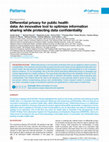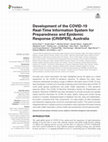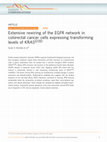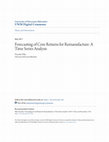Papers by Priyanka Pillai

Stemformatics is an established online data portal which hosts hundreds of curated gene expressio... more Stemformatics is an established online data portal which hosts hundreds of curated gene expression datasets. It has been serving the stem cell research community for over a decade, by hosting transcriptional profiles of pluripotent and adult stem cells and their progeny from multiple tissues and derivation methods. The portal provides easy-to-use online tools to explore gene expression patterns in published data. In recent years, Stemformatics has shifted its focus from curation to collation and integration of public data with shared phenotypes. It now hosts several integrated expression atlases based on human myeloid cells, which allow for easy cross-dataset comparisons and discovery of emerging cell subsets and activation properties. The inclusion of laboratory-derived cell types enables users to benchmark their own data, to assist with cell-type standardisation or improve cell-derivation methods. The sample annotations have been greatly improved to enable better data integration,...
<b>A minimum information model a virtual biobank based on the Minimum Information About BIo... more <b>A minimum information model a virtual biobank based on the Minimum Information About BIobank Data Sharing (MIABIS)</b>

This poster is presented in tandem with the Sensitive Data IG session at RDA18 (which shares the ... more This poster is presented in tandem with the Sensitive Data IG session at RDA18 (which shares the same name). In previous meetings, the Sensitive Data IG has scoped the interest and needs of the RDA community. At this meeting, we focus on specific challenges and opportunities associated with working with Sensitive Data. This poster explores one of these - how do we understand sensitive data definitions in different regions and disciplines, and how might we develop a shared language around sensitive data. For example, developing an understanding of different community agreed vocabularies and how these relate to each other. This poster will consist of three sections. First, case studies of different types of sensitive data will be presented. These will include, for example, case studies from the humanities, medicine, and military cases. Second, different classification systems for the level of sensitive data will be shown. This will explore, for example, what constitutes a high level o...

Stroke, 2015
Activity-dependent increases in blood flow comprise the basis for functional brain imaging and ar... more Activity-dependent increases in blood flow comprise the basis for functional brain imaging and are considered a hallmark of normal brain function. The central dogma of blood flow regulation states that flow changes effected by arteriolar tone drive functional hyperemia and that the capillary bed is a passive conduit for hyperemia resulting from upstream vasodilation. Recent evidence has begun to challenge this convention in cerebral blood flow control and suggests that pericytes may dilate capillaries during functional hyperemia, but whether pericytes can regulate flow of individual red blood cells (RBCs) through capillaries during sensory stimulation is unknown. Using high-speed two-photon microscopy in a live mouse model, we document that increases in RBC flow velocity and RBC flux through capillaries were detected within 1.0 second after sensory stimulation, and that the observed activity-evoked capillary hyperemia did not depend on the presence of a pericyte. We further report t...

As sensitive data are increasingly used for research purposes, reducing the risk of data misuse h... more As sensitive data are increasingly used for research purposes, reducing the risk of data misuse has become particularly crucial. At the same time, as demonstrated during the COVID19 crisis, sharing high-quality data is a sine qua non to assess and compare research results and to leverage data to their fullest capacity. The Sensitive Data Interest Group aims to promote the FAIR principles and reproducible research, while drawing attention to the unique risks associated with sensitive data and exploring mitigation strategies for these risks. Synthesis research that aggregates data at large scales often uses several kinds of sensitive data, but the ethical and legal issues are often not fully addressed, especially when harmonising differing ethical and legal considerations across regions. Further complicating matters, "sensitive data" are often not even defined in the same way. As a result, reproducing research in different regions or contexts is often difficult, and sensitiv...

Patterns, 2021
Coronavirus disease 2019 (COVID-19) has highlighted the need for the timely collection and sharin... more Coronavirus disease 2019 (COVID-19) has highlighted the need for the timely collection and sharing of public health data. It is important that data sharing is balanced with protecting confidentiality. Here we discuss an innovative mechanism to protect health data, called differential privacy. Differential privacy is a mathematically rigorous definition of privacy that aims to protect against all possible adversaries. In layperson's terms, statistical noise is applied to the data so that overall patterns can be described, but data on individuals are unlikely to be extracted. One of the first use cases for health data in Australia is the development of the COVID-19 Real-Time Information System for Preparedness and Epidemic Response (CRISPER), which provides proof of concept for the use of this technology in the health sector. If successful, this will benefit future sharing of public health data. BACKGROUND The coronavirus disease 2019 (COVID-19) pandemic has highlighted the need for the timely collection and sharing of public health data to provide information for policy makers and frontline workers to make rapid and informed decisions. It is important that sharing of data is balanced with protecting the confidentiality of an individual's health information. In this paper we discuss a cybersecurity method known as differential privacy, an innovative mechanism that could be used to optimize information sharing while protecting the confidentiality of public health surveillance data. Privacy refers to an individual's right to decide whether information about him or her is released, while confidentiality is an assurance given by a data holder that they will not violate any individual's privacy by releasing data the individual desires to be private. Privacy prevents information about a THE BIGGER PICTURE Differential privacy is an innovative technique that can be applied to data to protect confidentiality. This has been used primarily to protect private sector data, but has significant implications for public health. We describe the methods of differential privacy in terms understandable to a non-computerscience audience. To our knowledge, this is the first article describing differential privacy in language and context appropriate for a health audience. The case study described shows the feasibility of the use of differential privacy for public health surveillance data to optimize information sharing while protecting data confidentiality. This method allows for data to be released in more granular detail in terms of time, place, and person without compromising privacy and confidentiality. Future research needs to consider other use cases, including a range of surveillance systems and applications in other types of health data. Concept: Basic principles of a new data science output observed and reported ll

This is the final version of the Recommendations and Guidelines from the RDA COVID-19 Working Gro... more This is the final version of the Recommendations and Guidelines from the RDA COVID-19 Working Group, and has been endorsed through the official RDA process. The Research Data Alliance (RDA) COVID-19 Working Group members bring various, global expertise to develop a body of work that comprises how data from multiple disciplines inform response to a pandemic combined with guidelines and recommendations on data sharing under the present COVID-19 cicumstances. This extends to research software sharing, in recognition of the key role in software in analysing data. The work has been divided into four research areas (namely, clinical, omics, epidemiology, social sciences) with four cross cutting themes (namely, community participation, indigenous data, legal and ethical considerations, research software), as a way to focus the conversations, and provide an initial set of guidelines in a tight timeframe. The detailed guidelines are aimed to help stakeholders follow best practices to maximis...

Please cite as:* Handayani, A., Hegarty, B., Pillai, P., Spreadborough, K. (2021) The Cascade of ... more Please cite as:* Handayani, A., Hegarty, B., Pillai, P., Spreadborough, K. (2021) The Cascade of Care: How data models shape understanding of “monitoring and evaluation”, and “surveillance and survey”. Seminar Presentation. DOI: https://doi.org/10.26188/14883348*Authors listed in alphabetical orderA presentation given at UCoE - AIDS Research Center Atma Jaya Virtual International Seminar, 29 June, 2021, online. https://pph.atmajaya.ac.id/event/the-cascade-of-care-how-data-models-shape-understanding-of-monitoring-and-evaluation-and-surveillance-and-survey/ The HIV services cascade is a framework for identifying, measuring, and visualizing the magnitude of gaps in HIV services throughout the lifelong HIV care continuum. The cascade also becomes a data model which then becomes a component for policy makers and donors in seeing an overview of the progress of HIV prevention. There are two main elements required in cascade data collection. First, monitoring and evaluation which emphasizes...

Frontiers in Public Health, 2021
Accurate and current information has been highlighted across the globe as a critical requirement ... more Accurate and current information has been highlighted across the globe as a critical requirement for the COVID-19 pandemic response. To address this need, many interactive dashboards providing a range of different information about COVID-19 have been developed. A similar tool in Australia containing current information about COVID-19 could assist general practitioners and public health responders in their pandemic response efforts. The COVID-19 Real-time Information System for Preparedness and Epidemic Response (CRISPER) has been developed to provide accurate and spatially explicit real-time information for COVID-19 cases, deaths, testing and contact tracing locations in Australia. Developed based on feedback from key users and stakeholders, the system comprises three main components: (1) a data engine; (2) data visualization and interactive mapping tools; and (3) an automated alert system. This system provides integrated data from multiple sources in one platform which optimizes in...
Emergency Medicine Journal, 2021
Contributors CR performed the literature search. LC assembled the team of authors. LC, FB, RHJ, B... more Contributors CR performed the literature search. LC assembled the team of authors. LC, FB, RHJ, BG, SW and FW screened titles in the provided literature search, long-listed articles and hand-searched selected journals. LC and JS reviewed the long-listed and selected articles for inclusion. All authors contributed to writing of articles for inclusion and editing. The final submission was edited by LC, CR and JS.

Nature Communications, 2020
Protein-protein-interaction networks (PPINs) organize fundamental biological processes, but how o... more Protein-protein-interaction networks (PPINs) organize fundamental biological processes, but how oncogenic mutations impact these interactions and their functions at a network-level scale is poorly understood. Here, we analyze how a common oncogenic KRAS mutation (KRASG13D) affects PPIN structure and function of the Epidermal Growth Factor Receptor (EGFR) network in colorectal cancer (CRC) cells. Mapping >6000 PPIs shows that this network is extensively rewired in cells expressing transforming levels of KRASG13D (mtKRAS). The factors driving PPIN rewiring are multifactorial including changes in protein expression and phosphorylation. Mathematical modelling also suggests that the binding dynamics of low and high affinity KRAS interactors contribute to rewiring. PPIN rewiring substantially alters the composition of protein complexes, signal flow, transcriptional regulation, and cellular phenotype. These changes are validated by targeted and global experimental analysis. Importantly,...
International Journal, 2012
Abstract—This paper deals with the performance of Question Categorization based on four different... more Abstract—This paper deals with the performance of Question Categorization based on four different term weighting methods. Term weighting methods such as tf* idf, qf* icf, iqf* qf* icf and vrf together with SVM classifier were used for categorization. From the experiments ...

FORECASTING OF CORE RETURNS FOR REMANUFACTURE: A TIME SERIES ANALYSIS by Priyanka Pillai The Univ... more FORECASTING OF CORE RETURNS FOR REMANUFACTURE: A TIME SERIES ANALYSIS by Priyanka Pillai The University of Wisconsin-Milwaukee, 2017 Under the Supervision of Professor Wilkistar Otieno Over centuries, consumption of natural resources has been on a steady increase in response to the increasing global population. Increased and unsustainable use of natural resources in addition to increased manufacturing is affecting the environment adversely. Hence, governments and environmental protection agencies are implementing firm regulations for industries to reduce their footprint on environmental pollution, for instance by ensuring that their waste products are not only disposed sustainably but also reduced. In response to these regulations, industries have embraced product end-of-life management strategies. These include reverse logistic, material and product recovery, reusing, recyling and remanufacturing. This Thesis addresses one of the major challenges in remanufacturing which is uncerta...











Uploads
Papers by Priyanka Pillai